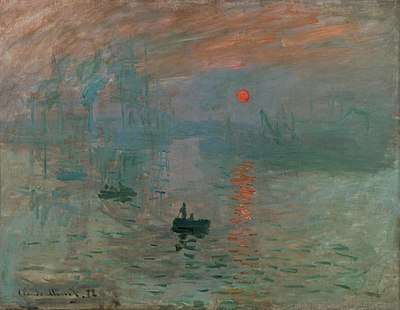Francisco Oller
Francisco Oller (June 17, 1833 – May 17, 1917) was a Puerto Rican visual artist. Oller is the only Latin American painter to have played a role in the development of Impressionism. One of the most distinguished transatlantic painters of his day, Oller helped transform painting in the Caribbean.[2]
Francisco Oller | |
|---|---|
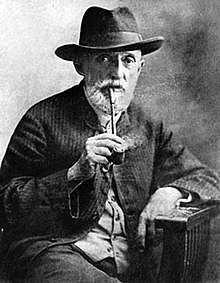 Francisco Oller | |
| Born | Francisco Manuel Oller Cestero June 17, 1833 Bayamon, Puerto Rico |
| Died | May 17, 1917 (aged 83) |
| Nationality | Puerto Rican |
| Education | Royal Academy of San Fernando, Thomas Couture, Gustave Courbet |
| Known for | Painting |
| Movement | Impressionism |
| Patron(s) | Museo de Arte de Ponce[1] |
Biography
Early years
Oller (birth name: Francisco Manuel Oller y Cestero [note 1]) was born in Bayamón, Puerto Rico, the third of four children of aristocratic and wealthy Spanish parents Cayetano Juan Oller y Fromesta and María del Carmen Cestero Dávila.[3][4] When he was eleven he began to study art under the tutelage of Juan Cleto Noa, a painter who had an art academy in San Juan, Puerto Rico. There, Oller demonstrated that he had an enormous talent in art and in 1848, when Oller was fifteen years old, General Juan Prim, Governor of Puerto Rico, offered Oller the opportunity to continue his studies in Rome. However, the offer was not accepted as Oller's mother felt that he was too young to travel abroad by himself.
When Oller was eighteen, he moved to Madrid, Spain, where he studied painting at the Royal Academy of San Fernando, under the tutelage of Don Federico de Madrazo y Kuntz, director of the Prado Museum. In 1858, he moved to Paris, France where he studied under Thomas Couture. Later he enrolled to study art in the Louvre under the instruction of Gustave Courbet.[5] During his free time, Oller, who had a baritone type of singing voice, worked and participated in local Italian operas. He frequently visited cafés where he met with fellow artists. He also became a friend of fellow Puerto Ricans Ramón Emeterio Betances y Alacán and Salvador Carbonell del Toro, who were expatriates in France because of their political beliefs. In 1859, Oller exhibited some of his artistic works next to those of Bazille, Renoir, Monet, and Sisley.[5]
For a short time, Paul Cézanne was one of Oller's students, although their professional relationship deteriorated with time. By 1865, Oller was known as the first Puerto Rican and Hispanic Impressionist artist. In 1868, he founded The Free Academy of Art of Puerto Rico.
Realism Period (1840–1903)
Oller’s paintings were a big contribution of history during this time. His paintings showed conflicts and daily lives of people outside of his home country as well as subjects internally. The author Edward J. Sullivan describes in his book, From San Juan to Paris and Back: Francisco Oller and Caribbean Art in the Era of Impressionism:
In the normal course of his day, the artist would have observed objects of quotidian use to the slaves and free persons of color with whom he regularly interacted. His world was not only the cultivated, Europeanized milieus of the Puerto Rican bourgeoisie, but also the realities of the relatively small city of San Juan, where he was born and where most of his career developed. Even during his many years of residence in Madrid and Paris, he would have carried with him the cultural baggage of his place of origin. His familiarity with the different strata of society on the Caribbean island of his birth was a constant reality as he intermingled with Realist and Impressionist artists and others who constituted his world on the other side of the Atlantic. This aspect of his personality cannot be easily separated from the other. Oller was a person of multiple cultural affinities, which allowed him to embrace what he saw abroad, but also to interiorize and reformulate those elements for purposes that conformed to his vision of tropical reality.[6]
Upon his return to Puerto Rico from France in 1866 he found himself face-to-face with slavery and he would create a number of works including El negro flageado (The negro being flogged), El castigo del negro enamorado (the punishment of the negro in love), and others depicting slavery in Puerto Rico.[7]
Impression Period (1874–1893)
Oller spent nearly two decades in Europe working alongside the pioneers of Impressionism, and, through his travels, participated in a vibrant exchange of aesthetic ideas, forging his own brand of international modernism while engaging social issues unique to the Caribbean. During his three trips to Paris, Oller affiliated himself with Paul Cézanne, fellow Caribbean artist Camille Pissarro (born in St. Thomas), and other members of the Impressionist and Post-Impressionist movements.[2]
Later years
Throughout his later life and after his death, Oller was compared to Jose Campeche as one of the most outstanding figures of the arts in his country. Campeche created an impressive body of portraits and religious subjects.[6]
In 1884, he founded an art school for young women[8] which was later to be known as the Universidad Nacional. In 1871, Spain honored Oller by naming him a member of the Caballeros de la Orden de Carlos III (which translates to Knighthood of the Order of Carlos III), and a year later he became the official painter of the Royal Court of Amadeo I. Oller developed an interest in bringing out the reality of Puerto Rico's landscape, its people, and culture through his works of art. Oller's paintings can be found in museums worldwide, including the Musée d'Orsay in France.
Oller died on May 17, 1917, in San Juan, Puerto Rico. He was buried at the Santa María Magdalena de Pazzis Cemetery in San Juan, Puerto Rico.
Styles and influences
Oller was a prolific painter with works ranging in topic from still-lifes and landscapes to historical events and portraiture.[8]While he was involved with several painting movements, Realism, Naturalism and Impressionism; he is best known for his Impressionist works.[8] Oller’s style of painting made him stand out among the many artists that took part in the depiction of Puerto Rico’s lush tropical landscapes of both rural and urban landscapes and provided a realistic image of Puerto Rico compared to the European artists that flocked over to the Caribbean to paint lush, idealized landscapes of the environment. Oller’s main subject matter of focus was everything within Puerto Rico, whether it was still life paintings of plantains and bananas or historical battle scenes. Oller's painting style provided a historical context for his painting, providing a cultural view through his own lens. Oller was involved with many art movements from the realist art movement, the naturalist art movement, and the impressionist art movement of which he is best known for. In his life, Oller spent nearly two decades in Europe working alongside the pioneers of these art movements, drawing influence from them in the evolution of his artwork. One characteristic that is quite apparent in his work that he drew influence from another artist is his sober, unidealized depictions of rural workers in Puerto Rico.
The "plantation portraits" by Oller, as well as those by Mendes Belisario in Jamaica and dozens of others throughout the Caribbean and the southern United States (where the plantations mostly served the cotton industry), were part of a long tradition of depictions of agriculture and servitude. Rarely, if ever, depicting the negative associations of enslaved or indentured labor, they attempted to create nostalgic views of the "old homestead," or a faraway venue of nostalgia. While Oller’s plantation pictures were executed in a somewhat different spirit, they nonetheless pertain to this genre that played a significant role throughout the development of visualization in a Caribbean context over a period of some 150 years.[6]
Oller was influenced by Barbizon school painter Jean-François Millet to paint in this way, allowing him to provide a realistic depiction of the life of Puerto Ricans in their historical context. In his early teachings, Frances Oller was taught by European painters at the time he learned at the Academia, including French neoclassical painter Jean Baptiste Vermay. His main source of influence in his early years comes from two Spanish painters, Luis Paret y Alcázar and, most significantly, José Campeche y Jordán. The artwork of José Campeche provided Oller a major point of reference for him in his young years as a developing artist. Oller was compared to Campeche as one of the most prominent artists in his country’s history. Oller not only drew inspiration from the work of Campeche but copied works of art by him and even lived in the artist’s former house.[8]
Selected works
- El pleito de la herencia (1854–1856)
- Retrato de Manuel Sicardó (1866–1868)
- El Estudiante (1874)
- Las lavanderas (1887–1888)
- Battle of Trevino (1879)
- Oller painted Colonel Juan Contreras as the central figure during a battle that took place on July 8, 1875. The battle was part of the Carlist Wars, a 19th-century war over the succession of the Spanish throne. Oller painted this during his final visit to Europe, where he was appointed as the official painter of the Spanish Court of King Alfonso XII. The artist opposed the conventions of realism and precision of more traditional military paintings. Instead, he uses Impressionistic style to capture the atmosphere and drama of the moment. Dabs of color blend together to create an out-of-focus effect. Oller also effectively use lines to draw attention of Colonel Contreras; the clouds, hills, and soldiers direct focus to the central figure. The author Edward J. Sullivan wrote:
The Battle of Trevino denotes a significant moment for Oller within the world of Spanish art. The painting represents an official theme of recent national history, through which the artist places himself in the tradition of military images that was of great importance in later nineteenth-century Iberian painting. The genre of battle painting is one of the least avant-garde artistic forms. Oller, an artist often associated with the "new" in art, is here going against that grain and inserting himself directly within a mode most often practiced by artists of a decidedly conservative personality. Nevertheless, he used this form as a way to experiment with the possibilities of a spontaneity and pictorial freedom within the framework of traditional subject matter.[6]
- La Escuela del Maestro Rafael Cordero (1890–1892)
- The subject of this painting, Rafael Cordero, was the founder of the first school in Puerto Rico for formerly enslaved and children of enslaved. By the late 1820s, the school admitted male children of all races and social strata. Cordero was both the sole instructor and manual laborer, making cigars and cigarettes in his workshop, where class took place. We can see his tobacco work table in the bottom right-hand corner. The children are of different culture and skin tones; the artist portrays the importance and accessibility of education to all races. The two children in the foreground, one holding an egg and the other holding bread, suggests the intermingling of race. As an abolitionist himself, Oller portrays the acceptance of race in the developing country during this time. Cordero's expression is exasperated and exhausted; despite this, he persists to provide education to the children. The setting is very conservative with religious symbolism on the walls. The walls are plain and cracked. Oller portrayed his subject as glamorous, as an "unsung hero".
- El Velorio ("The Wake") (1893)[8][9]
- This 8-by-13-foot painting was one of the few that had survived while many of his works were lost or damaged beyond repair. The Wake was not seen as the most glamorous but was shown in the Paris Salon in 1895. Oller uses small, visible brush strokes and an emphasis on an accurate depiction of light and mastery of color in its changing qualities in his paintings. The painting depicts the wake of death, a "baquiné", for a dead child laid on a table covered with flowers. Participants totally ignore the child and instead celebrate with food, drink, games, songs, dancing and prayer. The reason for this is that they believe it is a time for celebration for the child has become an angel and should be properly sent off. All the while the parents are mourning over the loss of their child and some are consoling the mother. Oller’s painting is considered a Puerto Rican national treasure and is not allowed to leave the Museum of History, Anthropology, and Art at the University of Puerto Rico's Río Piedras campus.[10]
- Bodegón con piñas
- El Cesante
- Hacienda La Fortuna de Ponce (1885)[11][12]
- La Ceiba de Ponce (1888)[13]
Legacy and remembrance
Oller was responsible for bringing Realism and Impressionism to San Juan, Puerto Rico. Combining them with the artistic traditions of San Juan, he revolutionized the school of painting in Puerto Rico and throughout the Caribbean region. Oller also helped bring outside world events by drawing them and displaying them publicly. Many Puerto Rican artists have followed in Oller's footsteps, including Ramón Fradé (1875-1954) and Miguel Pou (1880-1968).[9][14]
The town of Cataño in Puerto Rico, named a high school after him and the City of New York renamed P.S.61 in The Bronx P.S. Francisco Oller. There is also a Francisco Oller Library in the Escuela de Artes Plásticas (School of Plastic Arts) in San Juan. The Francisco Oller Museum where many artists, such as Tomás Batista, exhibit their work is located in the city of Bayamón. In Buffalo, New York there is a Francisco Oller and Diego Rivera Museum of Art where Manuel Rivera-Ortiz and other artists have exhibited their work.
Gallery
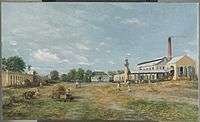 Hacienda La Fortuna, 1885. Brooklyn Museum
Hacienda La Fortuna, 1885. Brooklyn Museum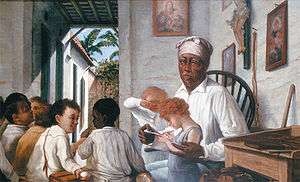 La Escuela del Maestro Rafael Cordero (1890–1892)
La Escuela del Maestro Rafael Cordero (1890–1892)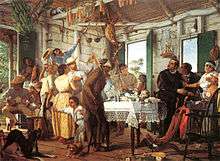 El Velorio (1893)
El Velorio (1893)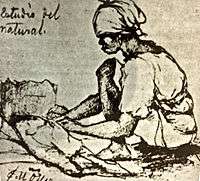 Estudio del Natural, (1866–72)[15]
Estudio del Natural, (1866–72)[15]
Notes
- This article uses Spanish naming customs: the first or paternal family name is Oller and the second or maternal family name is Cestero.
References
- "Feature Exhibition: Mi Puerto Rico". Newark Museum. Archived from the original on April 29, 2011. Retrieved July 10, 2012.
- "Impressionism and the Caribbean: Francisco Oller and His Transatlantic World". Blanton Museum of Art. 2016-06-14. Retrieved 2019-05-01.
- Catalogue Commemorating the Exhibition the Art Heritage of Puerto Rico: Pre .. By Museo del Barrio (New York, N.Y.), Metropolitan Museum of Art (New York, N.Y.)
- http://nobox.net/voz/prog_216.mp3 (in Spanish) "Oller en Europa": Haydée Venegas' interview by La Voz del Centro
- Raynor, Vivien (February 10, 1984). "Francisco Oller, Puerto Rico Glimpsed". Art. The New York Times.
- Sullivan, Edward J. (2014). From San Juan to Paris and back : Francisco Oller and Caribbean art in the era of impressionism. New Haven. ISBN 978-0300203202. OCLC 875644436.
- ""El negro flagelado" , la obra perdida del abolicionista Francisco Oller" (in Spanish). Retrieved 16 June 2019.
- Spiegelman, Willard (8 July 2015). "A Voyager Among Countries and Styles". The Wall Street Journal. p. D5., electronic copy published as Spiegelman, Willard (7 July 2015). "'Impressionism and the Caribbean: Francisco Oller and His Transatlantic World' Review". The Wall Street Journal. Archived from the original on 13 July 2015.
- "Francisco Oller, tropical impressionniste de Puerto Rico - Invitation au voyage". ARTE TV (in French).
- Johnson, Ken (2015-10-01). "Francisco Oller, Core of 'Impressionism and the Caribbean,' at the Brooklyn Museum". The New York Times. ISSN 0362-4331. Retrieved 2019-10-14.
- Collazo, Edwin Velázquez (17 June 2012). ""Hacienda Fortunata" (sic) de Francisco Oller a la colección del Brooklyn Museum". arte coa / arte de puerto rico y el caribe: Revista Digital de Arte Caribeño, Contemporáneo e Internacional. Archived from "Hacienda_Fortunata"_de__Francisco_Oller_a_la_colección_del_Brooklyn_Museum the original on 7 April 2014.
- Photograph - PONCE - A Sugar Refinery or Plantation near City of Ponce, P. R. circa 1898. [Identified by a viewer as Hacienda La Matilde] - Vintage Photo measures 7 x 5 inches. Flickr. Retrieved 5 September 2013.
- Fundación Puertorriqueña de las Humanidades. Ponce Ciudad Museo 2001. 2001. p. 111.
- "Francisco Oller". Google Arts & Culture (in Aragonese). Retrieved 8 November 2019.
- "El pañuelo de la negra: notas sobre la construcción artesanal de la memoria" (PDF). Archived from the original (PDF) on February 2, 2016. Retrieved January 27, 2016.
Further reading
- The art heritage of Puerto Rico, pre-Columbian to present. New York: The Metropolitan Museum of Art and El Museo del Barrio. 1973.
